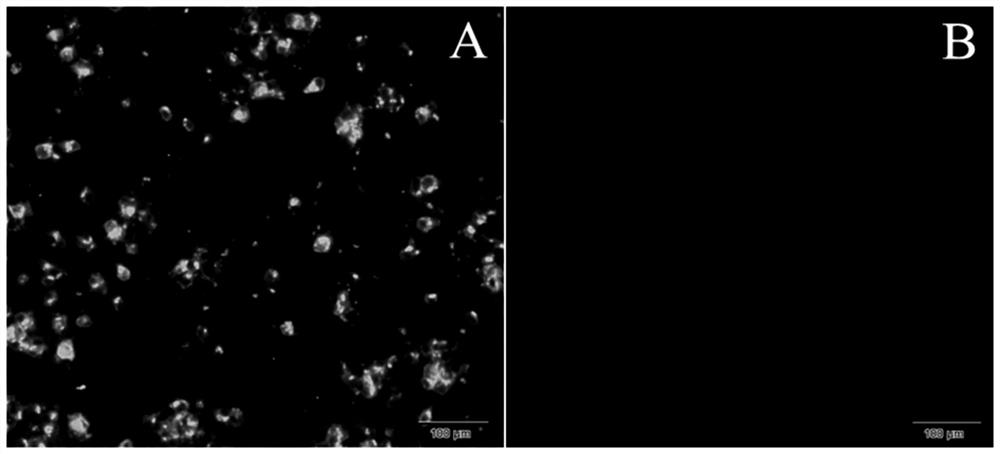A kind of hybridoma cell line secreting anti-cphv-1 monoclonal antibody and its application
A monoclonal antibody and hybridoma cell technology, applied in the field of immunity, can solve the problems of easy false positives and long time consumption, and achieve no adverse reactions, good sensitivity and specificity, and no reduction in antibody neutralization titer Effect
- Summary
- Abstract
- Description
- Claims
- Application Information
AI Technical Summary
Problems solved by technology
Method used
Image
Examples
Embodiment 1
[0070] Example 1 Establishment of monoclonal antibody hybridoma cell line
[0071] 1, Preparation of CPHV-1 antigen
[0072] The inventors have been separated from a new type of CPHV-1, a new type of CPHV-1, a cultivation of a new type of CPHV-1, is separated from a cultivated respiratory tract infection. -04-10) The poisonous strain has a large variation of foreign floating drug strains. Only 919 amino acids are encoded in foreign epidemic strains, while domestic epidemic strains JSHA1405GB gene encodes 920 amino acids, and occurs 11 mutations of 11 amino acid sites. The strain was inoculated by a 0.01-0.1MoI in vaccination of MDBK cells (purchased from China Veterinary Drug Supervision), placed in 37 ° C, 5% CO 2 The cell culture is collected in the cell culture box, and the cell culture was collected at 48 hours after the drug, repeatedly frozen three times, and centrifugally, 40 000 g speed centrifugation 2h, discarded the supernatant, precipitated with an appropriate amount o...
Embodiment 2
[0081] Example 2 Preparation of Ascites
[0082] The sterilized liquid paraffin abdominal cavity injected 10-12 week old BALB / C mice (purchased from Yangzhou University Comparative Medicine Center), 0.5ml / only, 7d, after 7 days, the hybridoma cell line was injected into mice, each 0.2 ML (including 2 × 10 6 -3 × 10 6 Hybridoma cells), after 7-10 days, the abdomen of the mouse in the abdomen was taken after 7-10 days, and 5000 rpm was centrifuged for 10 min. Collect the supernatant, place the spare in -20 ° C after dispensing.
Embodiment 3
[0083] Example 3 Virus neutralization test
[0084] Ascites prepared by stably secreting CPHV-1 monoclonal antibodies were used to carry out CPHV-1 neutralized and experiments, respectively, and a monoclonal antibody hybridoma cell line with high secretion and high titers were further screened. First, determine the TCID of CPHV-1JSHA1405 strains 50 . The MDBK cells were digeulated using a fixed viral dilution antibody, and the MDBK cell was digested in a 96-well cell plate. The mice of the 10x series diluted monoclonal antibodies are 200tcid respectively. 50 The CPHV-1 suspension was mixed uniform, 37 ° C for 1 h, and 0.1 ml of the viral-antibody suspension was taken in the 96-well cell plate, and CphV-1 and normal MDBK cell control were set, placed in 37 ° C. 5% CO 2 Culture in the cell incubator and observed after 2D. In the hybridoma cell line of 89 CPHV-1 specific monoclonal antibodies, mice prepared by 4A4 strains of hybridoma cells were the highest, neutralized and high of 2...
PUM
 Login to View More
Login to View More Abstract
Description
Claims
Application Information
 Login to View More
Login to View More - R&D
- Intellectual Property
- Life Sciences
- Materials
- Tech Scout
- Unparalleled Data Quality
- Higher Quality Content
- 60% Fewer Hallucinations
Browse by: Latest US Patents, China's latest patents, Technical Efficacy Thesaurus, Application Domain, Technology Topic, Popular Technical Reports.
© 2025 PatSnap. All rights reserved.Legal|Privacy policy|Modern Slavery Act Transparency Statement|Sitemap|About US| Contact US: help@patsnap.com


